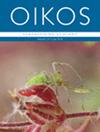生物多样性丧失和恢复期间的生态系统功能
IF 3.1
2区 环境科学与生态学
Q2 ECOLOGY
引用次数: 0
摘要
人为的生物多样性丧失会损害生态系统的功能。人类活动通常以扭转生物多样性丧失及其相关功能影响为目标进行管理。然而,在生物多样性恢复过程中观察到的生物多样性-生态系统功能(BEF)关系是否与生物多样性丧失过程中观察到的关系相同,目前还不得而知。这将取决于物种灭绝和重新定居的顺序是如何比较的,以及不同物种是如何影响生态系统功能的。利用海洋底栖无脊椎动物群落的数据,我们模拟了生物扰动潜能(底栖生态系统功能的替代物)在生物多样性丧失和恢复过程中的变化情况,这些变化分别受物种对物理干扰的敏感性和重新定殖能力的影响。尽管物种灭绝和重新定居的顺序不同,但生物多样性丧失和恢复的生物扰动潜势关系基本相同。无论假定种群在物种消失或增加时是否表现出补偿反应,这种情况都是如此。这些研究结果表明,当地生物多样性丧失的功能性后果可以通过减轻其驱动因素来逆转,因为在生物多样性丧失和恢复阶段,物种丰富程度相当的不同物种具有相似的功能性效应。对我们基于模型得出的结果进行经验验证并确定其普遍性是未来研究的潜在步骤。本文章由计算机程序翻译,如有差异,请以英文原文为准。
Ecosystem functioning during biodiversity loss and recovery
Anthropogenic biodiversity loss can impair ecosystem functioning. Human activities are often managed with the aim of reversing biodiversity loss and its associated functional impacts. However, it is currently unknown whether biodiversity–ecosystem function (BEF) relationships observed during biodiversity recovery are the same as those observed during biodiversity loss. This will depend on how species extirpation and recolonisation sequences compare and how different species influence ecosystem functioning. Using data from a marine benthic invertebrate community, we modelled how bioturbation potential – a proxy for benthic ecosystem functioning – changes along biodiversity loss and recovery sequences governed by species' sensitivity to physical disturbance and recolonisation capability, respectively. BEF relationships for biodiversity loss and recovery were largely the same despite species extirpation and recolonisation sequences being different. This held true irrespective of whether populations were assumed to exhibit compensatory responses as species were removed or added. These findings suggest that the functional consequences of local biodiversity loss can be reversed by alleviating its drivers, as different species present at comparable levels of species richness during biodiversity loss and recovery phases have similar functional effects. Empirically verifying and determining the generality of our model‐based results are potential next steps for future research.
求助全文
通过发布文献求助,成功后即可免费获取论文全文。
去求助
来源期刊

Oikos
环境科学-生态学
CiteScore
6.20
自引率
5.90%
发文量
152
审稿时长
6-12 weeks
期刊介绍:
Oikos publishes original and innovative research on all aspects of ecology, defined as organism-environment interactions at various spatiotemporal scales, so including macroecology and evolutionary ecology. Emphasis is on theoretical and empirical work aimed at generalization and synthesis across taxa, systems and ecological disciplines. Papers can contribute to new developments in ecology by reporting novel theory or critical empirical results, and "synthesis" can include developing new theory, tests of general hypotheses, or bringing together established or emerging areas of ecology. Confirming or extending the established literature, by for example showing results that are novel for a new taxon, or purely applied research, is given low priority.
 求助内容:
求助内容: 应助结果提醒方式:
应助结果提醒方式:


